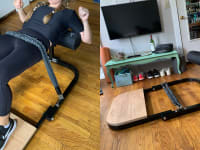Can the DB Method machine replace squats?
It claims to deliver a "dream butt"—but we're not so sure.
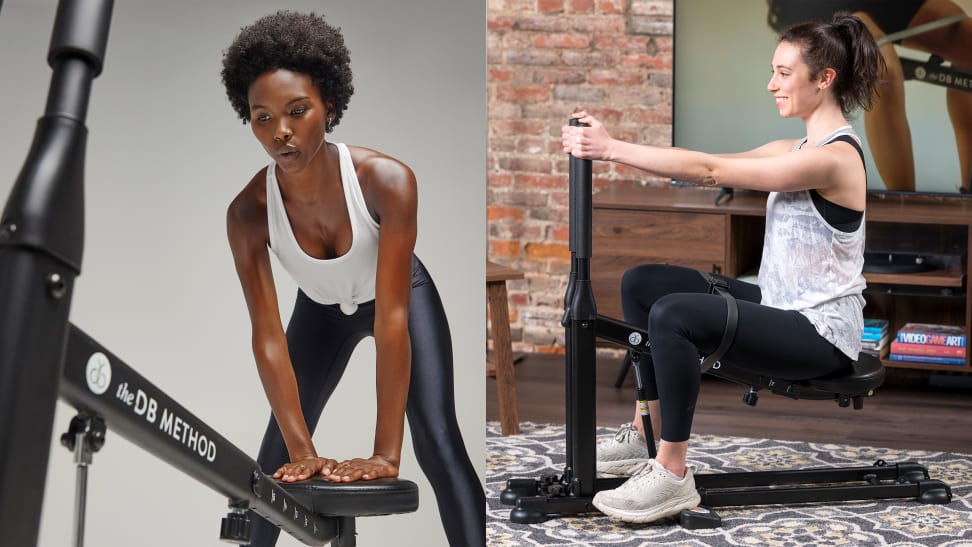 Credit:
The DB Method
Credit:
The DB Method
Products are chosen independently by our editors. Purchases made through our links may earn us a commission.
The simple squat is one of the best exercises you can do. With proper form, the move works the core, calves, quads, hamstrings and, of course, the glutes, making it a powerhouse exercise that can (and should!) be implemented into any workout routine.
But achieving that correct form requires practice and focus, particularly if you’re newer to fitness. For some, this is where the DB Method squat machine could look appealing.
The maker of this piece of equipment claims it can perfect the simple squat by making it easier and more efficient to perform, shifting your center of gravity to take the weight out of the knees and deliver it straight to the glutes. But does the classic squat even need this upgrade? DB Method sent me a machine and some accessories so I could test it out. I used it for about two months—here’s what I think, including if it’s worth it.
What is the DB Method?
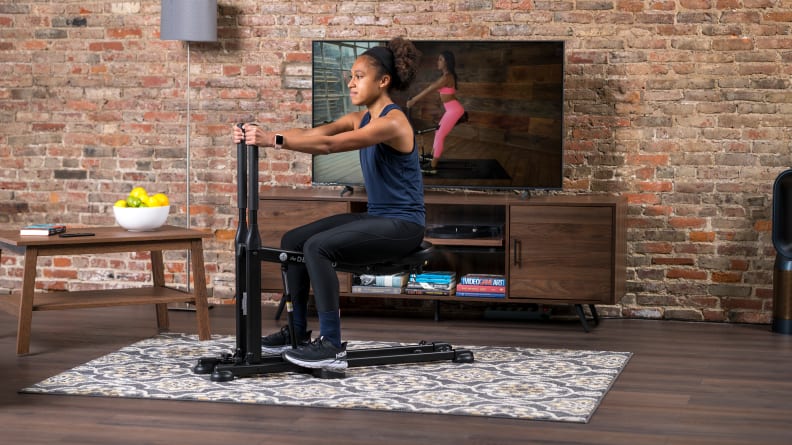
The DB Method is an assisted squat machine that claims to perfect the glutes.
For $329, the DB Method squat machine promises to deliver you a “dream butt.” (Yes, that’s what its initials stand for—if that’s too subtle for you, the handles bear its logo, a lowercase “d” and “b” overlaid in such a way to look like a big, fat peach.)
To accomplish this, the machine is constructed with two parallel upright handles at the front, a wide cushioned seat that moves up and down on a hydraulic rod, and two foot rests on either side. You sit on the seat, place your feet on the rests, hold onto the handles, and squat deeply. The seat and its hydraulics take some of your body weight off, so you can squat lower and without putting pressure on your knees, thereby activating the glutes and targeting the exercise to your nether regions.
If you’re of a certain demographic, you’ve probably seen it on your Instagram feed or in tabloids when Kim Kardashian gave it to her mom and sisters for Christmas a couple of years ago. The brand claims that doing DB Method workouts for 10 minutes a day will “transform” your body. It doesn’t spell out exactly what it means by this, but you can probably put it together using your imagination, desires, the name of the machine, and the before-and-after photos on its Instagram—a rounder, tauter booty, and maybe some flatter abs and toned inner thighs.
According to the company, the machine is suitable for people between 5 feet tall and 6 feet, 2 inches tall and up to 250 pounds.
The DB Method sent me its $443 “Essentials” kit, which currently includes the $329 machine, a polyurethane yoga mat dubbed the “Dreammat” ($32 if bought separately), a resistance band called the “Dreamband Pro” ($22), and a 10-pound weighted belt called the “Dreambelt” ($60)—if you’re paying attention, you’ll notice that there’s no discount for buying all the items together.
My kit included the phone/tablet holder named “Dreammount”, which retails for $34. You can also add on accessories, including 2-pound wrist and ankle weights called “Dreamlets” for $30 and floor gliders called “Dreamdiscs” for $18.
I was also given access to the DB Method app, which costs $10 a month or $100 a year and includes 5- to 15-minute home workout videos led by DB Method’s trainers. Right now, the first month is free, though you can still watch some of its videos without a subscription.Get the DB Method app
If you try it out and decide DB Method isn't for you within the first 30 days, you can return it for a full refund (minus a delivery fee, depending on the shipper you use).
How does the DB Method work?
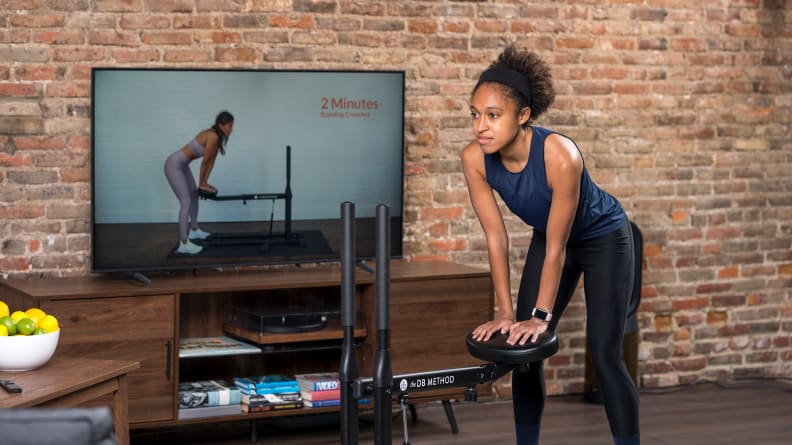
You can use the machine for core and arm workouts, too.
The machine does not come assembled, but putting it together doesn’t require any tools—all you have to do is clip its components together. It comes with a booklet that spells out how to do it, but I supplemented with the DB assembly video, which provides good visuals. It took me about 15 minutes to get it set up. You can also fold it up by unscrewing the hydraulic rod and pulling the seat through the arms so it’s easier to store.
Once it was set up, I watched DB Method’s "getting started" video. It describes how to adjust the seat, which can be pulled in and out and set at a number from 1 to 6 based on your height. The introduction also provides instructions for proper form. To use it, you put your heels on the foot ramps with your toes pointing up, extend your arms to gently grip the handlebars, rest your glutes on the seat while engaging your core, and squat, keeping your weight shifted back the whole time. When squating, the seat is the only thing that moves: Your arms stay on the handrails and your heels stay on the foot pads. You can also dismount to use it for non-glute exercises, such as chest and tricep presses for the upper body and oblique curls for the core.
I had questions about that 10-minutes-a-day claim, so I spoke with DB Method’s chief fitness officer (CFO) and personal trainer Adam Swartz. He says you should start to notice results with daily 10-minute sessions within three to four weeks. He says people of all fitness levels should notice something, though squat newbies are more likely to see dramatic improvements. Swartz also says the machine should make you feel better overall. “If you’re just starting out and fairly sedentary, just getting into the beginnings of a squat motion can be really life-changing,” he says. “If you’re more advanced and not involving some regular squatting, there's a lot a squat can unlock in terms of strength.”
I tested the machine like most people might: I used it most days of the week—the device lived at Reviewed’s office, so I skipped the weekends—and kept an eye on my booty to see how it fared.
How does the DB Method compare to a regular squat?
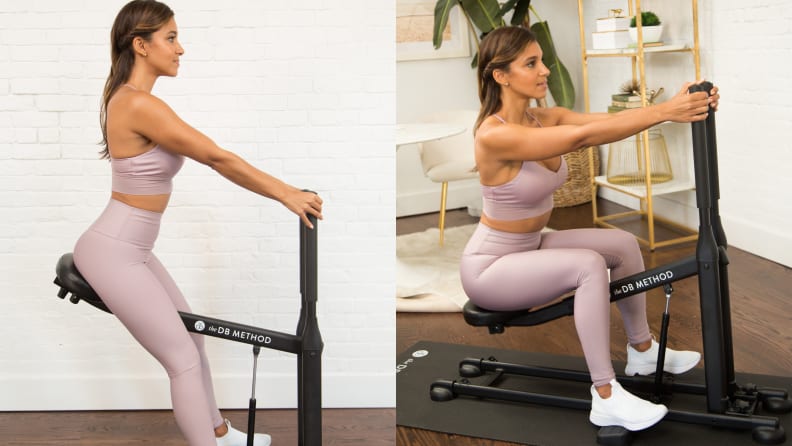
The DB Method squat feels a bit more like a chair pose than a typical squat.
People usually had two reactions when I told them I was testing this machine. Those who had seen the Instagram ads immediately asked me to fill them in on my findings. Those who had not been as relentlessly targeted squinted at the imagery when I inevitably showed them DB Method’s colorful, video-filled Instagram and said something along the lines of, “Why not just stick with regular squats?”
It’s a fair question. For my part, I’ll say that squatting with the DB Method machine felt different and more challenging than a regular body-weight squat, likely because my weight was shifted farther back than usual and my arms were extended. To me, it felt more like a yoga chair pose, a standing posture that involves shifting downward like you’re about to sit in a chair and hovering in place. This meant that I really felt it in my glutes and inner thighs, and, when I remembered to tighten my core, I felt it there, too.
But I also felt compelled to ask Swartz who, presumably, is accustomed to dealing with questions of the sort. “The traditional squat is a technically difficult exercise,” he says. “It’s hard to figure out the right engagements ... if you don’t have a trainer right there working with you. It can be done, but it has a barrier to entry. For people who don’t have access to a coach, the DB Method can help achieve proper form.”
One common body-weight squat mistake includes putting too much weight in the front of your body, causing your knees to cave in or extend over the feet. From my experience, the DB Method prevents this. But achieving DB-perfect form by doing the same motion over and over may not always be useful for your overall fitness routine, or even prevent you from making these mistakes if you try to do a body-weight squat on your own. I spoke with Pete McCall, a personal trainer and fitness educator who’s not affiliated with the DB Method, for a previous story about similar squat machines. He thought the machine could be useful for developing confidence and base strength, but felt the repetitive movements may not help you learn how to squat on your own and could be ineffective or even risky. This is because doing the same motion over and over again can cause repetitive stress injuries.
What I like about the DB Method
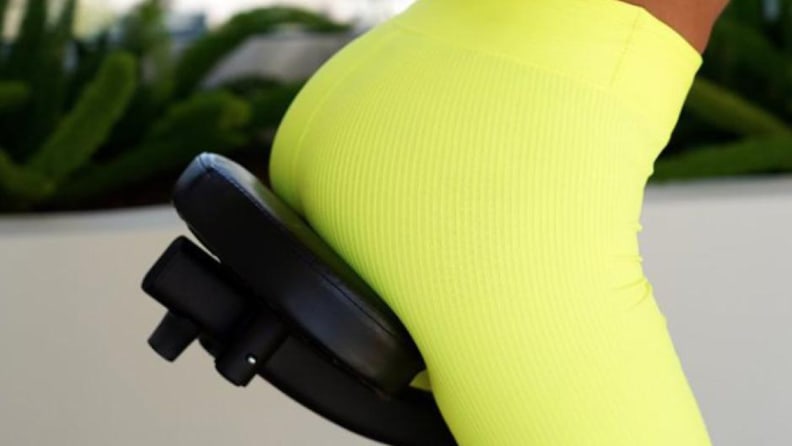
The DB method does work the glutes well.
It’s fun and has a low barrier for entry
In addition to the different, more intense "burn" I felt, I genuinely looked forward to using the DB Method machine—an important consideration for any exercise device. Knowing that I was going to use it for only 10 minutes made it much easier to hop on than, say, a treadmill, which I usually approach with the dread that comes from knowing I'm committing to at least a 30-minute run, no matter how good I know I'll feel when I'm don). And I felt the effects of DB even after those 10 minutes, too—not enough to consider making it my only workout of the day, but enough that I felt justified coming back to it each workday.
It might give you some results
Anecdotally, I also noticed a physical difference during my testing period. My butt didn’t get bigger, per se, and it definitely didn’t become a Kardashian-esque butt. (You’d need more than the DB Method for that.) But it seemed a little perkier and I noticed that a pair of leggings I usually hate wearing started to look a lot more flattering. That said, I don’t know if I can attribute this entirely to the machine—I also started running outside more as the weather got warmer and taking classes at my local barre studio once I received the COVID vaccine. Still, I feel confident saying that, at the very least, the DB Method helped.
What I don’t like about the DB Method
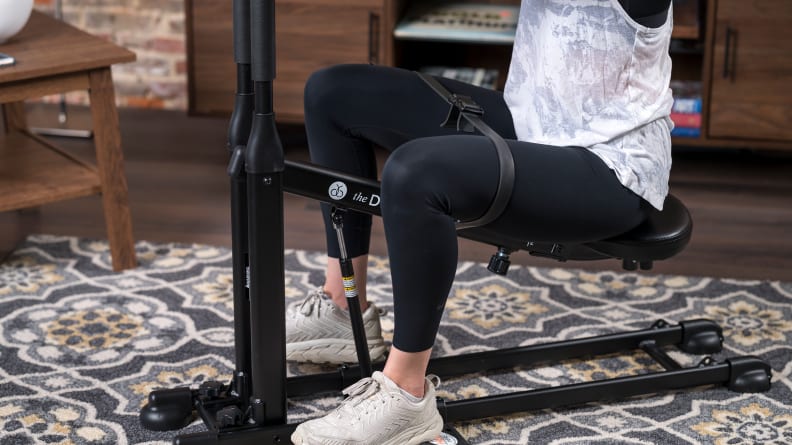
Most of the app workouts called for additional accessories, like this branded resistance band.
It’s expensive for what it is
It’s hard for me to justify the DB Method’s $329 price. Yes, I'd argue it does what it says it does, but you don’t need it to learn how to squat or build your glutes. A good tutorial video and commitment to keeping good form (perhaps by watching yourself in a mirror) could help you learn how to squat without a trainer.
McCall also suggested alternate exercises if you’re mainly interested in building glute muscle, such as hip thrusts. If you belong to a gym, this is a much better option, as you can access the equipment without having to commit to a machine at home.
The DB Method app isn’t great
I wasn’t wowed by the DB Method’s app, either. I liked the instructors, who were all engaging and provided clever ways to use the machine, such as using squats with different ranges of motion and adding pulses. But most of the videos require equipment other than the DB Method machine (the resistance band and discs were required most often), which makes the videos feel more like a means of shilling product than anything else. It also doesn’t have a lot of videos—24, by my count—and didn’t seem to be updated during my testing period.
Some of the videos are arranged into “challenges,” which provide a workout schedule with daily exercises to complete for a set period of time. This is a nice touch, but the videos quickly get repetitive, and I just don’t think it’s worth the $10 monthly price. If you’re good about remembering to cancel free trials, you can check it out for yourself with a month-long subscription—if not, I’d try the DB Method’s YouTube page first, which provides about 40 free home workout videos.
It doesn’t feel like a complete workout
Finally, as much as I looked forward to using the machine, it left my workouts lacking. And that's because it isn’t a complete workout—ultimately, this machine is designed for one purpose and one exercise. So even when I did a lengthier full-body DB Method workout video, I always felt like I needed to add a run, Pilates class, or additional strength training to get my exercise fix for the day. Of course, I test exercise equipment for a living, which keeps me pretty active. Your opinion may differ based on your own fitness level.
Is the DB Method worth it?
Maybe, if you understand what you’re getting (and what you’re not)
We should all be wary of fitness devices and routines that rely heavily on aesthetic results for one specific part of the body—two attributes the DB Method fulfills in its marketing. It’s disingenuous to say that you should never factor in appearance as motivation to start working out, but focusing on doing one motion for one purpose can result in boredom and disappointment if you don’t get the promised results fast enough. If you resent the machine, you won’t use it, and then it definitely won’t work.
With that in mind, I think the DB Method is worth it for some people. Sure, it’s a one-trick pony (OK, maybe a one-and-a-half trick pony). But it could be a good option for someone who doesn’t have a lot of fitness experience, doesn’t own a lot of fitness gear, doesn’t belong to a gym, just wants to fit some squatting into the day without thinking about it too much, and doesn’t mind the cost of the machine. If that sounds like you, you’ll like that the DB Method provides the ability to squat without putting pressure on the knees and potentially noticeable, if not dramatic, results. The key is to manage expectations, use it regularly, and maybe add in some cardio, which could be as simple as walking around more. With that, I think you’ll start to feel stronger and more confident, which should be what fitness is all about.


